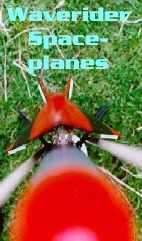
An Introduction To Waveriders
Waverider Theory
Most vehicles flying above mach 5 have rounded noses and wing-edges, as this cuts down on the high thermal loading the vehicles receive when the boundary layer of air initially flowing past the vehicle's skin at high Mach number gives up most of its kinetic energy as heat. This is why the Space Shuttle, for example, has a rounded nose and wing leading-edges.
Shockwaves, which always occur above Mach 1, and which bend back to glove the vehicle creating them at high Mach numbers, cannot bend themselves around rounded curves without physically detaching themselves from the vehicle skin. This means that there is a physical gap between the wing-edges and nose of say, the Space Shuttle, and its shock-surface.
Hypersonic vehicles during re-entry generate lift only from the underside of the fuselage. The underside, which is highly inclined to the flow at a high angle of attack, causes in conjunction with the underside shock-surface, compressive lift in reaction to the inclined vehicle wedging the airflow downwards.
If the wing leading-edges are rounded, and swept-back as on most hypersonic delta-winged vehicles, the underside shock-surface is detached, allowing a large fraction of the underside compressed airflow to leak out round the side of the wings through the gap between the shock-surface and the wing leading-edges. This wastes up to a quarter of the potential lift.
Waveriders have sharp noses and wing leading-edges, which the underside shock-surface attaches to, therefore air flowing in through the shocksurface is trapped between the shock and the fuselage, and can only escape at the rear of the fuselage. Shocks are one-way, the second law of thermodynamics prevents air flowing back through a shock the way it came in.
All the lift is retained, so although sharp edges get a lot hotter than rounded ones at the same air density, the improved lift means that Waveriders can re- entry glide at much higher altitudes where the air-density is lower. Re-entry heating is a function of air density, so infact waveriders suffer much reduced re-entry heating rates, provided their wing-areas are large compared to their mass.
The waveriding concept: fitting sharp edges to any arbitrary hypersonic vehicle shape, evolved simultaneously in Britain and the U.S.S.R, though the only vehicle ever built (as far as is known) was the American XB-70 Mach3 bomber prototype, back in the early sixties.
Most people think of two particular vehicle shapes in conjunction with the waveriding concept: The 'Caret' Waverider, in effect a triangular delta-wing bent down the middle to give negative dihedral. It roughly resembles an ascii Caret symbol: '^' in cross-section. The other generic vehicle shape resembles, the gothic-arch planform of a steam-iron with an inverted 'W' cross-section, and is derived from conic hypersonic flow solutions.





